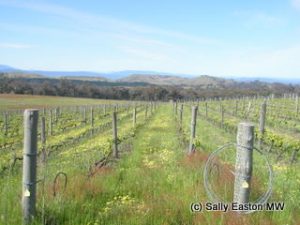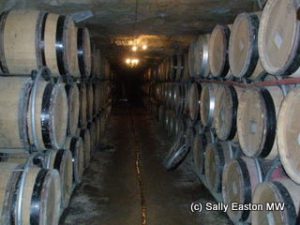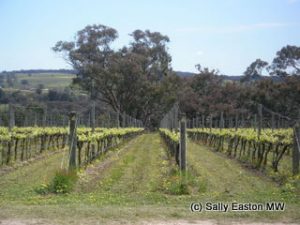Beechworth, Victoria, a Langton’s 2010 trilogy
Tucked away in north east Victoria, 40 miles from Rutherglen, famed for its world class stickies, but a million miles from it stylistically, lies the small, unassuming region of Beechworth. It’s about a three hour drive, in opposite directions, to both Melbourne and Canberra.

Savaterre's south-facing vineyard
A little bit of altitude has made all the difference for Beechworth. While Rutherglen sits around 170m above sea level, Beechworth varies from 300 to 700m. This is enough of a difference, in just an hour’s drive, to move from the required heat of Rutherglen to the significantly cooler Beechworth, where the altitude of the Victorian Alps plays its part to the extent that slopes become an important feature to ameliorate the risk of frost.
It’s not to say that Beechworth is cool climate. Halliday’s Wine Atlas of Australia (2006) gives heat degree days of 1240 to 1687, which spans Winkler and Amerine’s regions I to III, though the mean January temperature of 19.9°C to 20.4°C is firmly ensconced in region II. There is some diurnal temperature variation, which is important to preserve aroma in the fruit. Hot days of 35 to 40°C generally cool off during the night to around 20°C.
More than two dozen growers work in Beechworth and vineyard holdings tend to be small, with the individual or family approach to viticulture being the dominant theme.
There were vineyards here in the 1800s with the gold rush. Indeed, the affluent Beechworth town is Australia’s oldest gold mining town and the centre retains much of that 19th century provincial charm. But the modern viticultural pioneer is Rick Kinzbrunner who set up Giaconda in 1980, and who has virtually single-handedly led the region to niche stardom. It is only in the last decade that vineyards have started to expand as this delightful niche gains wider kudos. The acclaimed Langton’s classification acknowledged this with two new Beechworth entrants into their 2010 list.
Rick, and son Nathan, who joined the business full-time just two years ago, farm a total of 12 hectares, 4 ha on the Giaconda site, 4 ha on the Warner family vineyard where the Giaconda – Warner vineyard shiraz is made, and another 4 ha in a joint venture with Nathan’s cousin, Peter Graham (who is also the assistant winemaker at Giaconda), and Frenchman Michel Chapoutier, also planted to shiraz and a bit of nebbiolo, for the Ergo Sum label.

Giaconda's maturation cave
The family is still excited about the cave recently dug under the hill below the winery, which has a steady 15.5°C temperature, and which now houses the wines maturing in cask.
The 2010 chardonnay was picked in several passages from the bottom of the cooler south-facing slope on February 19th to the top of the slope on March 10th. A natural yeast fermentation followed in 40% new French oak, where, Nathan said, the wine will lay on its lees for about two years. The chardonnay has long been among the top, exceptional, category of the Langton’s classification.
Immediately on the other side of the road, Giaconda acolyte Keppell Smith, set up Savaterre in the mid 1990s. An émigré from the financial world, Smith “couldn’t understand why one of the best wineries – Giaconda – was here, and no-one else was.” He figured all that perfume, elegance and structure couldn’t all be due to the man, so the decomposed granite with clay soil must have something to add. He planted 5 ha of pinot noir and chardonnay, along with some recently added shiraz, on a similarly south-facing slope. He said he’ll release his first vintage of shiraz, the 2010, if it’s up to scratch.
The idiosyncratic Smith uses some (non-certified) biodynamic techniques such as enriching the soil with bacteria. In the winery he insists he’s “just babysitting”, saying “I leave it alone, no yeast, not bacteria, I press in a basket press so I oxidise early, but I need a substantial piece of fruit if I’m going to sculpt” something remarkable. But in leaving a wine alone, the attention to detail needs to be microscopic; he said “every 1% you muck up, it’s cumulative.”
Smith’s chardonnay jumped into the distinguished category of Langton’s emerging classics in 2010.
In both the Giaconda and Savaterre chardonnay, intense, multi-layered, sweet-savoury flavours from lengthy lees ageing give the wines added complexity and intrigue, with more of an ‘old world’ feel. These are serious, sophisticated and sublime chardonnays.

Castagna
The Langton’s trilogy is completed by the second new entrant, Castagna, whose property neighbours Giaconda. Indeed, ex-film director and individualist, Julian Castagna worked vintages for Rick for several years as part of his winemaking training.
Castagna bought his land in 1997 and immediately planted vines, and shiraz is the tour de force here, and it is the Genesis Syrah which is also categorised as distinguished. The vines are planted on north and east-west facing slopes, for greater warmth for the shiraz.
Castagna got his shiraz cuttings from original Aussie material – clones and selections from Barossa and McLaren Vale. He’s also planted sangiovese, viognier and nebbiolo, and the vineyards now take up 4 hectares.
Of his shiraz, Castagna said “I make shiraz the way most people make pinot noir, with great care. We only pick till 11 a.m. The fruit is always cold when it comes in. It gets a cold soak of up to six days pre-fermentation. And the fermentation uses whole bunches and whole berries.”
The Genesis has a couple of per cent of viognier in it. Sophistication and seriousness are the bywords again, along with fine, silky-smooth tannin structure, and savoury, graphite notes.
Giaconda, plus the Warner and Ergo Sum vineyards, and Castagna and Savaterre have sewn up the 400 to 500m altitude block on the approach road into Beechworth, like four proud corners of a box on either side of the road.
My research visit to Australia in October 2010 was sponsored by Wine Australia.
Comments
3 Responses to “Beechworth, Victoria, a Langton’s 2010 trilogy”




January 1, 2011 at 9:39 am
A comprehensive and enlightening article, even for us locals. We done.
January 4, 2011 at 2:57 pm
Very interesting post Sally. I confess I’ve only just become aware of Beechworth through my recent contact with Julian Castagna and look forward to taking it in on my next visit to Oz
January 4, 2011 at 5:25 pm
Thanks Fiona. It was my first visit too, spent a brief and revelatory 24 hours there. Make sure you stay at http://www.theprovenance.com.au when you go … ab fab food and room.